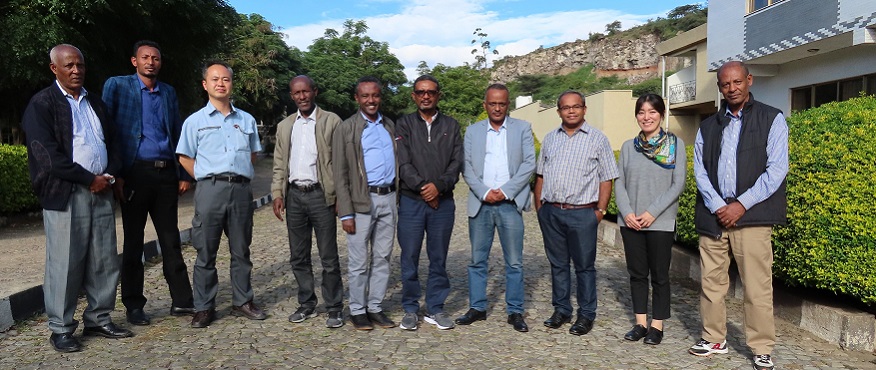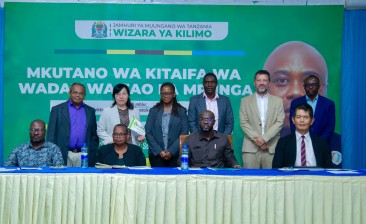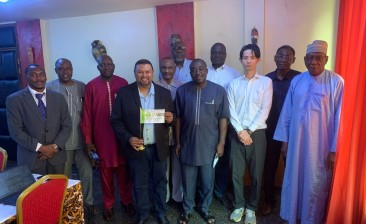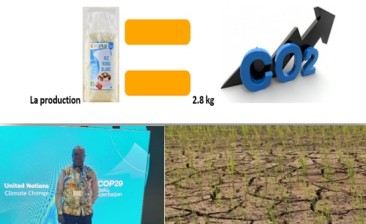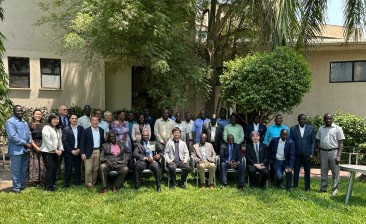Ethiopia, October 2019
CARD Working Week for developing NRDS-2 in Ethiopia
Rice is declared as a ‘millennium crop’ in Ethiopia. Although traditional cereal food crops such as Teff and Wheat are still the predominant choice of food markets in Ethiopia, the consumption demand for rice is growing faster than these traditional crops, at a rate of 7% per annum. The first phase of NRDS-1 (referred to as National Rice Research and Development Strategy in Ethiopia; NRRDSE) aimed to drastically increase the domestic rice production between 2009 and 2018. Recent National Statistics however revealed that the production increased only by about 2-fold during this period. While doubling rice production, which is the target of CARD, was achieved, the domestic rice market is faced with a self-sufficiency rate of just 23%. The government of Ethiopia is hence keen to revive its efforts in developing the rice sub-sector through a second phase of NRDS.
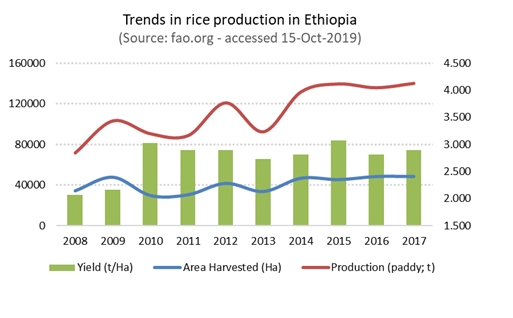
The Ministry of Agriculture (MoA) has recently set up a taskforce with a mandate of preparing the NRDS-2 (2019-2030). Under the guidance of one of CARD supporting partners, JICA-Ethiopia office, the taskforce members had met and discussed the current situation in August and wrote sections that could constitute the background of a zero NRDS-2 draft. Subsequently the taskforce requested the CARD Secretariat to provide technical guidance on developing the key strategies for developing the rice value chain. The intention is to take the NRDS-2 draft to a final stage for validation by the country’s stakeholders. In response, the CARD Secretariat conducted a working week and dispatched a consultant for providing assistance to the taskforce in identifying key strategic elements for the NRDS-2.
CARD activity and the results
With sponsorships from Ethiopia’s Ministry of Agriculture and JICA-Ethiopia; CARD organized the workshop at Kereyu Hill Resort Hotel in Adama between 7th and 11th October,2019. A regional consultant from CARD facilitated the discussions on the development of the NRDS-2 at the workshop. About 8 taskforce members participated throughout the working week and representatives from JICA-Ethiopia office and Saudi Star (a private firm engaged in large-scale commercial rice production in Ethiopia) participated as resource persons.
CARD’s objectives were to guide the taskforce members in (i) appraising their preliminary draft on current situation of the rice value chain and (ii) developing the other required contents (targets, goal, objectives and key strategic elements) of the NRDS-2. The consultant from CARD first briefed on the expected outputs of the workshop and the outline of the NRDS format proposed by the CARD Secretariat. Although the strategy document of the NRDS phase-1 (2009-2018) in Ethiopia was termed as NRRDSE; since research and development represent only one of the many intervention elements of the sub-sector development; the taskforce members agreed that the phase-2 shall be called as NRDS-2.
Through a participatory method, the reporter engaged the taskforce members in discussions on the goal, targets and objectives of the NRDS-2. Given the weak attention that the rice sector development has received from the stakeholders during the phase-1; the taskforce widely acknowledged that attaining full self-sufficiency (from the current level of 23%) can be an uphill task. It was nevertheless agreed that 3 target-scenarios can be set up towards achieving (i) 45%, (ii) 65% and (iii) 100% self-sufficiency by 2030. The goal of the NRDS-2 was hence agreed as ‘increased production, productivity and quality of domestic rice so as to drive the sub-sector towards self-sufficiency’.
The taskforce members then brainstormed on the NRDS’s strategic framework. In this context, the resource persons from JICA and Saudi Star Ltd. provided additional inputs on the potential interventions and provided their long-term perspectives on rice sub-sector development. These discussions enabled the taskforce in establishing 3 strategic objectives viz., (a) increase production, (b) raise productivity and (c) enhance competitiveness of the rice sector. The members then identified major themes of interventions under each objective; and set generic indicators through which progress in implementation of the NRDS shall be monitored and evaluated.
Way forward
The Validation Workshop for the NRDS-2 is now set in December.
